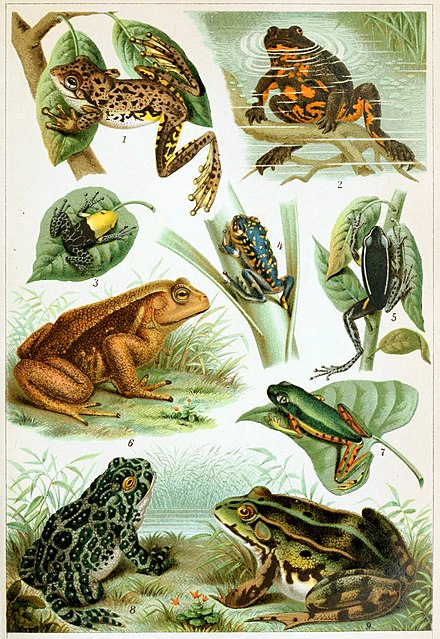Frogs are a group of amphibians that usually have smooth skin, long hind legs, and can jump and swim. Here are some details about frogs and their habits:

Appearance: Frogs usually have smooth skin, large eyes, wide mouth and developed hind legs, which allow them to jump long distances.
Size: Frogs vary in size and shape, from some very small tree frogs to some very large species, ranging from roughly 2 cm to 30 cm.
Color: Frogs also come in a variety of colors, with some species being predominantly green, while others have gray, brown, or other colored appearances.
Range: Frogs are widely distributed on all continents (except Antarctica), including tropical, subtropical and temperate regions.
Habitat: Frogs live in various ecosystems such as lakes, rivers, marshes, grasslands, forests and deserts.
Amphibious life: Frogs can live in water and on land, and they have different habits in the aquatic and terrestrial stages.
Reproduction: Most frogs undergo external fertilization. After laying eggs, the female frog mixes the egg with the female frog sperm, and the male frog releases the sperm onto the surface of the egg, completing the fertilization process. The fertilized eggs hang in the water and hatch into tadpoles.
Feeding: Frogs are carnivores, feeding on insects, worms, small invertebrates and small vertebrates. Some large species of frogs also prey on small birds, small mammals, and other frogs.
How to catch: Frogs usually catch their prey with their tongue. They have a well-developed hyoid bone and mucus that allows them to quickly stick out their tongues to catch food.
Dormancy: In cold environmental conditions, some frogs choose to hibernate in order to survive the cold winter.
Frogs have a variety of species, including:
Tree frog: good at climbing trees, mostly in the crown or tree hole activities.
River frog: lives in streams and rivers and feeds mostly on aquatic insects.
Bullfrog: more aquatic habits, more living in lakes, ponds.
Wood pecker frog: Mainly distributed in Australia and New Guinea, many species hibernate in cold climates.
Many frog populations are threatened by factors such as habitat loss, infectious diseases in the captive industry, climate change, and human activities. As a result, many organizations and researchers are working to protect frogs and their habitats to ensure their survival and reproduction.
Frogs are little-known species that have attracted attention for their unique amphibious lifestyle, diverse species, and important role in ecosystems. To protect frogs, it is essential to protect their habitat, reduce environmental pollution and deforestation, and control illegal fishing.
animal tags:
We created this article in conjunction with AI technology, then made sure it was fact-checked and edited by a Animals Top editor.